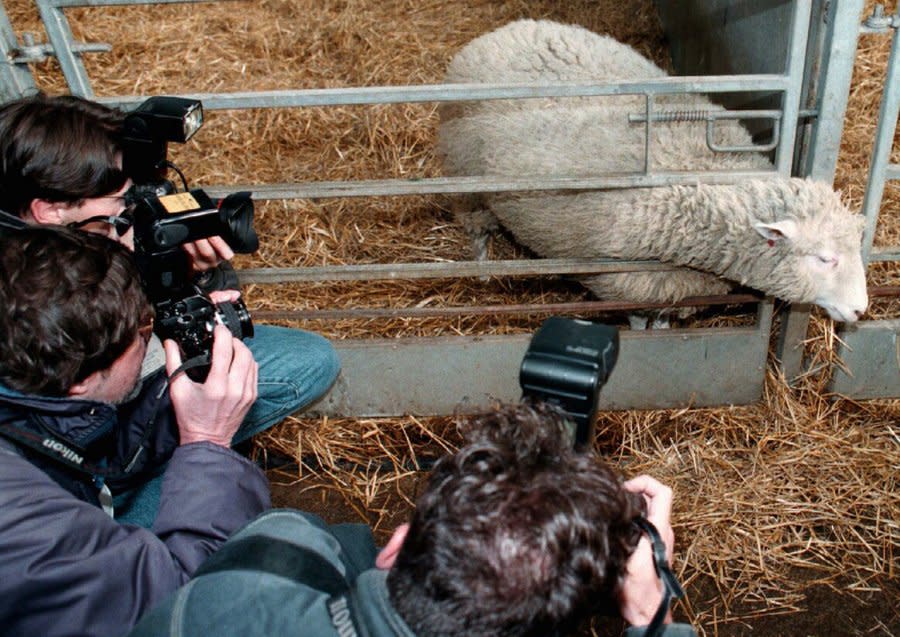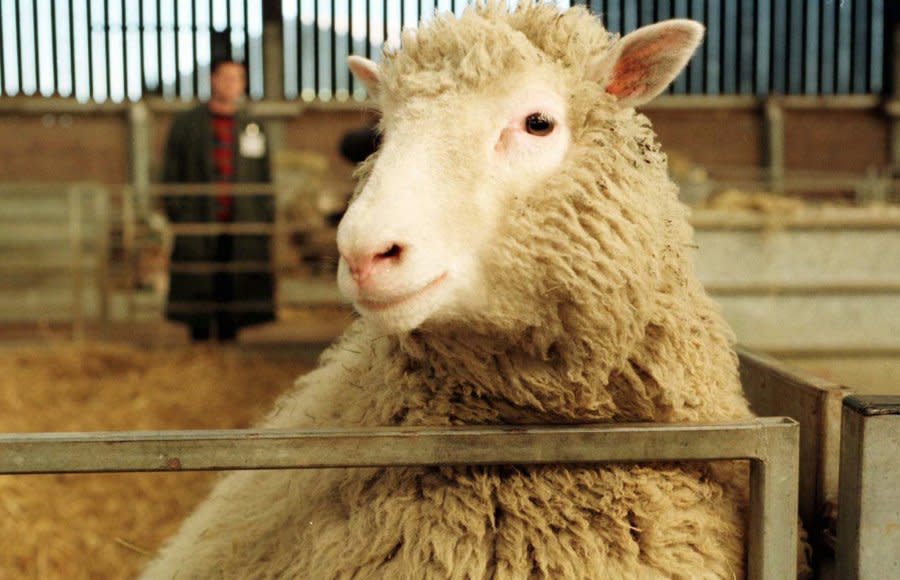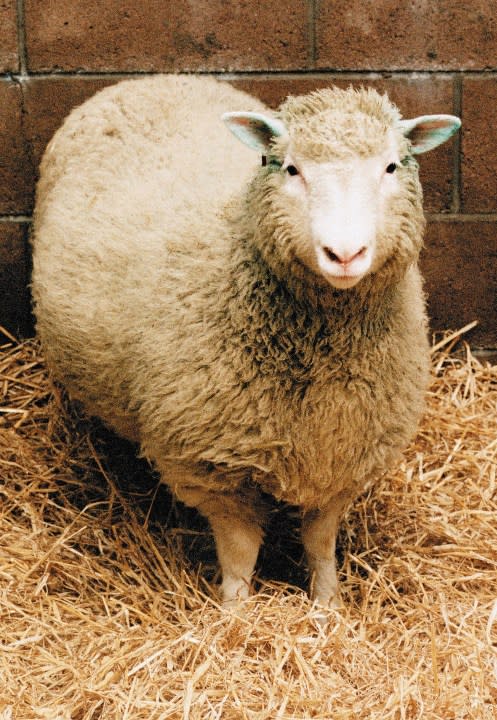On this date: Dolly the Sheep meets the world

EDINBURGH, SCOTLAND (WHTM) — It was an achievement that many scientists believed was impossible. On Feb. 22, 1997, a scientific team headed by Professor Ian Wilmut at the Roslin Institute, part of the University of Edinburgh, introduced Dolly the Cloned Sheep to the world.
The misconceptions, misconstruals, misinterpretations, misapprehensions, and misoneisms started almost immediately.
Get daily news, weather, breaking news and alerts straight to your inbox! Sign up for the abc27 newsletters here
A lot of people thought Dolly was the first animal to be cloned, ever. In fact, the first successful clonings, of frogs and fish, were done in the 1950s and 1960s. And as the Rosling Institute explains on its website, Dolly was not even the first cloned mammal.
Would you spend $50,000 to clone your dog?
“That honour belongs to another sheep which was cloned from an embryo cell and born in 1984 in Cambridge, UK. Two other sheep, Megan, and Morag, had also been cloned from embryonic cells grown in the lab at The Roslin Institute in 1995 and six other sheep, cloned from embryonic and fetal cells, were born at Roslin at the same time as Dolly. “
Seven-month-old Dolly, the genetically cloned sheep, is surrounded by the media at the Roslin Institute Tuesday February 25 1997. I(AP Photo/Newsflash) **UNITED KINGDOM OUT** FILE This Tuesday, Feb. 25, 1997 file photo shows seven-month-old Dolly, the genetically cloned sheep, looking towards the camera at the Roslin Institute in Edinburgh. (AP Photo/Paul Clements, File) UK OUT Dolly the Sheep, the world’s first cloned mammal, circa 2000. Veterinarians gave Dolly a lethal injection February 14, 2003 at Scotland’s Roslin Institute after they discovered signs of progressive lung disease. (Photo by Getty Images)
So what was it about Dolly’s birth that caused such excitement? She was the first mammal cloned from an adult cell. The process, called Somatic Cell Nuclear Transfer, starts by removing the genetic material from an egg cell, then replacing it with the genetic material from a different animal.
Dolly was cloned using genetic material from a mammary gland cell of a six-year-old Finn Dorset sheep, implanted into an egg cell from a Scottish Blackface sheep. Another Scottish Blackface served as her surrogate mother. When she was born on July 5, 1996, Dolly’s had the white face of a Finn Dorset, rather than the black face of her surrogate mother, proof she was indeed a clone. Because Dolly’s DNA came from a mammary gland cell, the research team named her after Dolly Parton. Science humor…
Do cloned pets actually look and act like the original?
The big breakthrough within the big breakthrough was that they did this with a specialized cell. An embryo starts out as a single cell. As the cell divides, and the embryo starts to grow, the cells start to differentiate, becoming, heart cells. liver cells, lung cells, brain cells, mammary gland cells-cells that specialize to perform a specific purpose. Dolly proved it was possible to reset the clock and make an adult cell act like a newly fertilized embryo.
The implication was that it would be possible to take a cell culture from, say, a prize cow, chicken, or sheep, and produce dozens, hundreds, thousands, or even millions of precise duplicates.
The other implication was that you could use human cells to create a clone army.
The pro and con arguments about cloning continue to this day, even though the type of cloning used to create Dolly has pretty well fallen by the wayside. As it turned out, Somatic Cell Nuclear Transfer had a low success rate. Dolly was the only animal born out of 277 cloned embryos, and years of research failed to improve the percentage of viable clones. And in the meantime, a better method was developed- Induced Pluripotent Stem Cells, or iPSC.
Nobel prize in medicine awarded for research on evolution
The technology of iPSC was developed by Japanese scientists Shinya Yamanaka and Kazutoshi Takahashi. In the early 2000s, they discovered by taking an adult cell and adding a few special genes, the cell would revert to an unspecialized form-a stem cell. The discovery has revolutionized genetic research while avoiding some of the ethical quandaries of SCNT cloning.
Stay up to date on the latest from abc27 News on-air and on the go with the free abc27 Mobile app.
As for Dolly herself, she continued living a normal sheepish life at the Roslin Institute. She had six lambs with a Welsh Mountain ram called David; Bonnie 1998, twins Sally and Rosie in 1999, and triplets Lucy, Darcy and Cotton in 2000.
Soon after giving birth to the triplets, The institute suffered an outbreak of a virus called Jaagsiekte sheep retrovirus (JSRV), which causes lung cancer in sheep. Dolly was one of those infected. In February 2003, Dolly developed a cough, and a CT scan showed tumors in her lungs. Rather than allow her to suffer, the Institute put Dolly to sleep on Feb. 14, 2003, at the age of six.
Get the latest Pennsylvania politics and election news with abc27 newsletters!
Six years old is about half the usual lifespan of a sheep. When Dolly was a year old, the team at the Institute ran an analysis of her DNA and discovered her telomeres, the “caps” found at the end of chromosomes, were shorter than they should be for sheep of that age. Telomeres protect the DNA in chromosomes from damage, and get shorter as an organism ages. When Dolly died, it was widely presumed her short telomeres were (a) a result of cloning, and (b) at least partly responsible for her early demise-in effect, she was “older” than her years.
Fifth person cured of HIV after stem cell transplant, researchers say
However, as the Roslin Institute website reports, “extensive health screens on Dolly at the time did not find any conditions which could be directly related to premature or accelerated aging.” And studies of cloned animals have found shorter, longer, and normal telomeres. So it’s hard to prove Dolly’s early death was directly related to cloning.
Since 2003, Dolly has been on display at the National Museum of Scotland in Edinburgh. Twenty years later, she’s still one of their most popular exhibits.
For a list of animals that have been cloned, click here.
For the latest news, weather, sports, and streaming video, head to ABC27.




